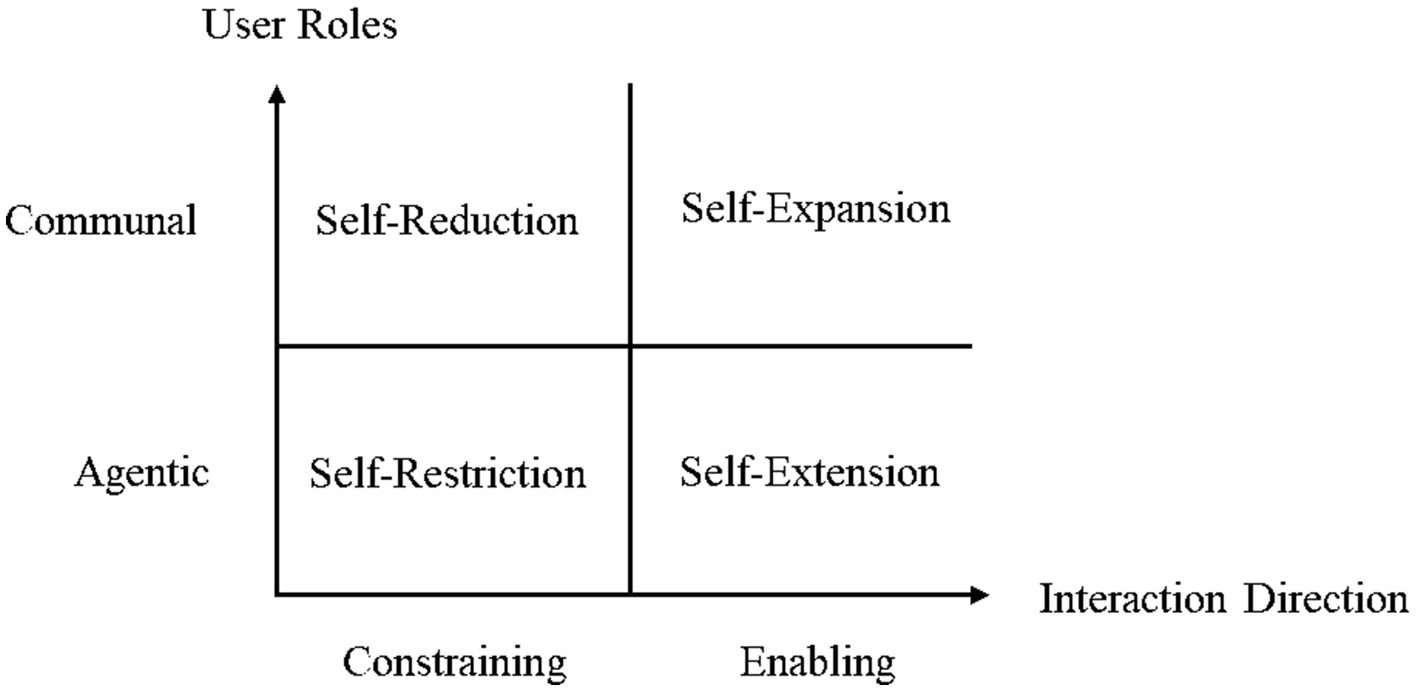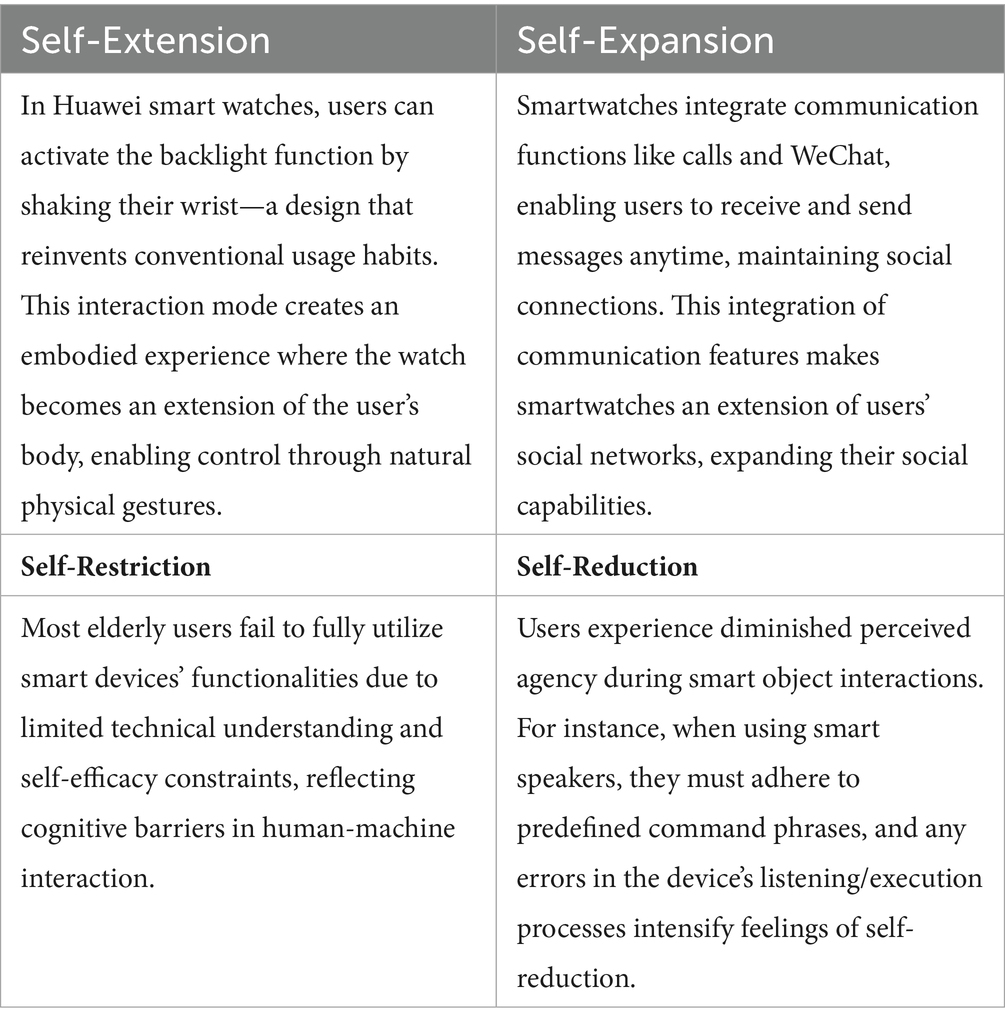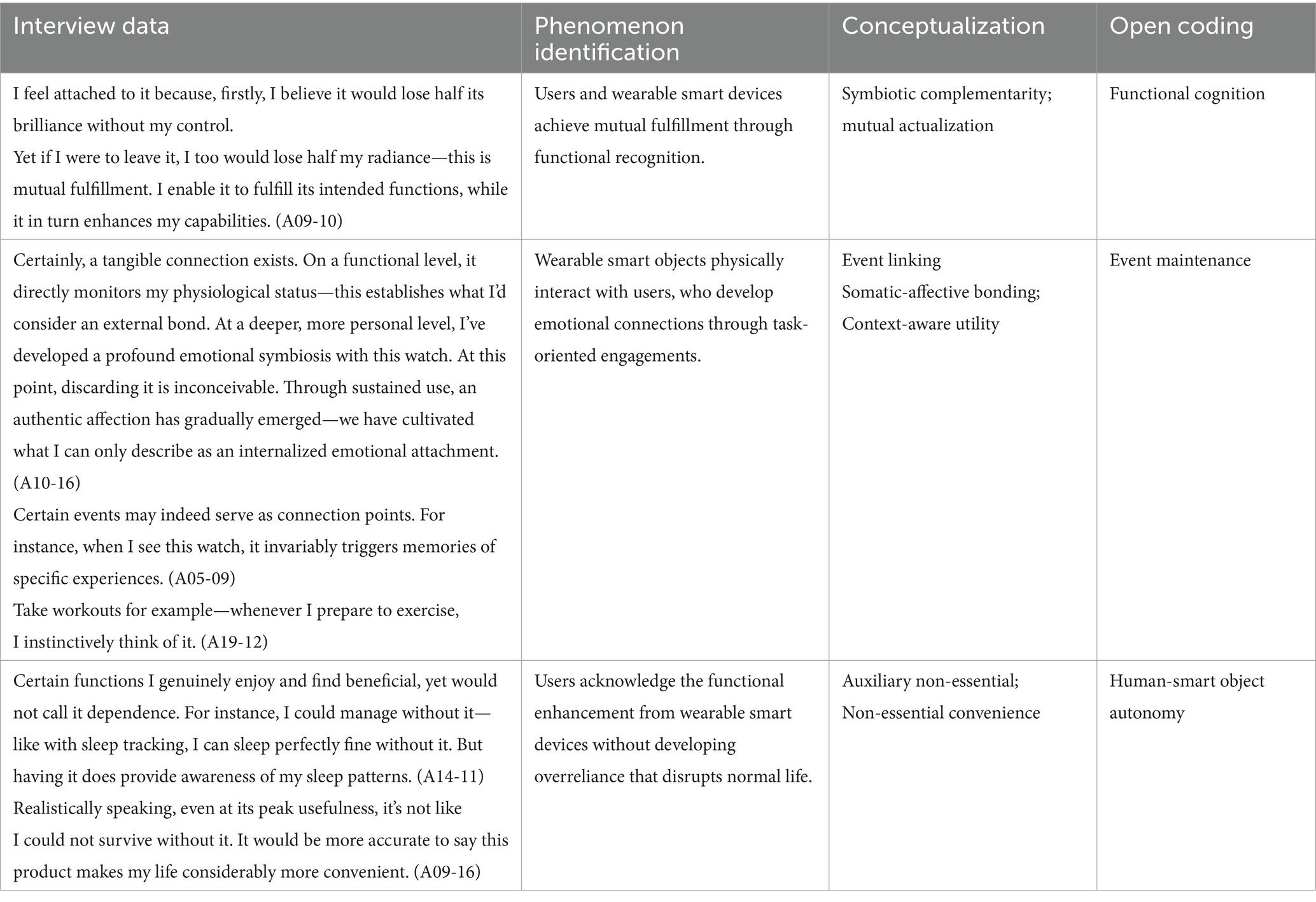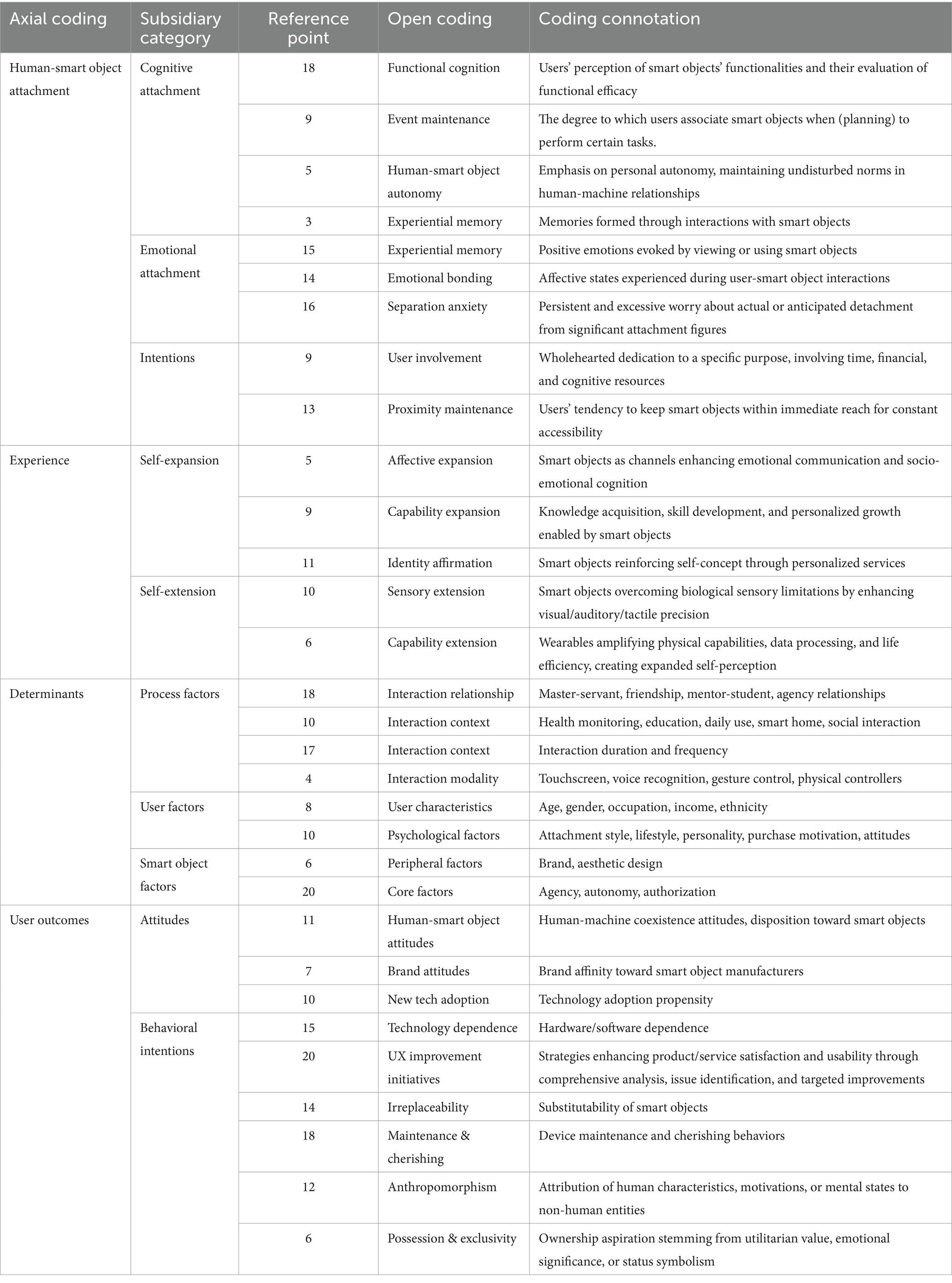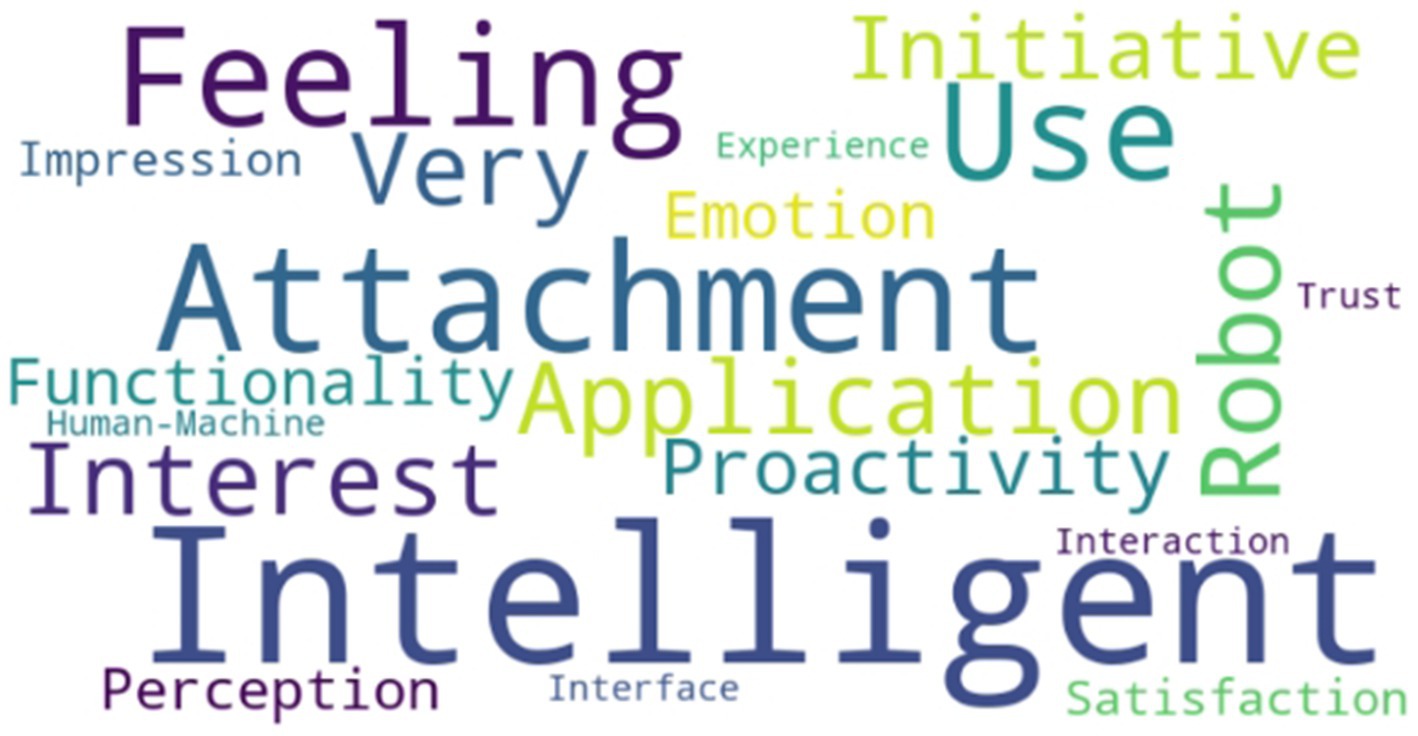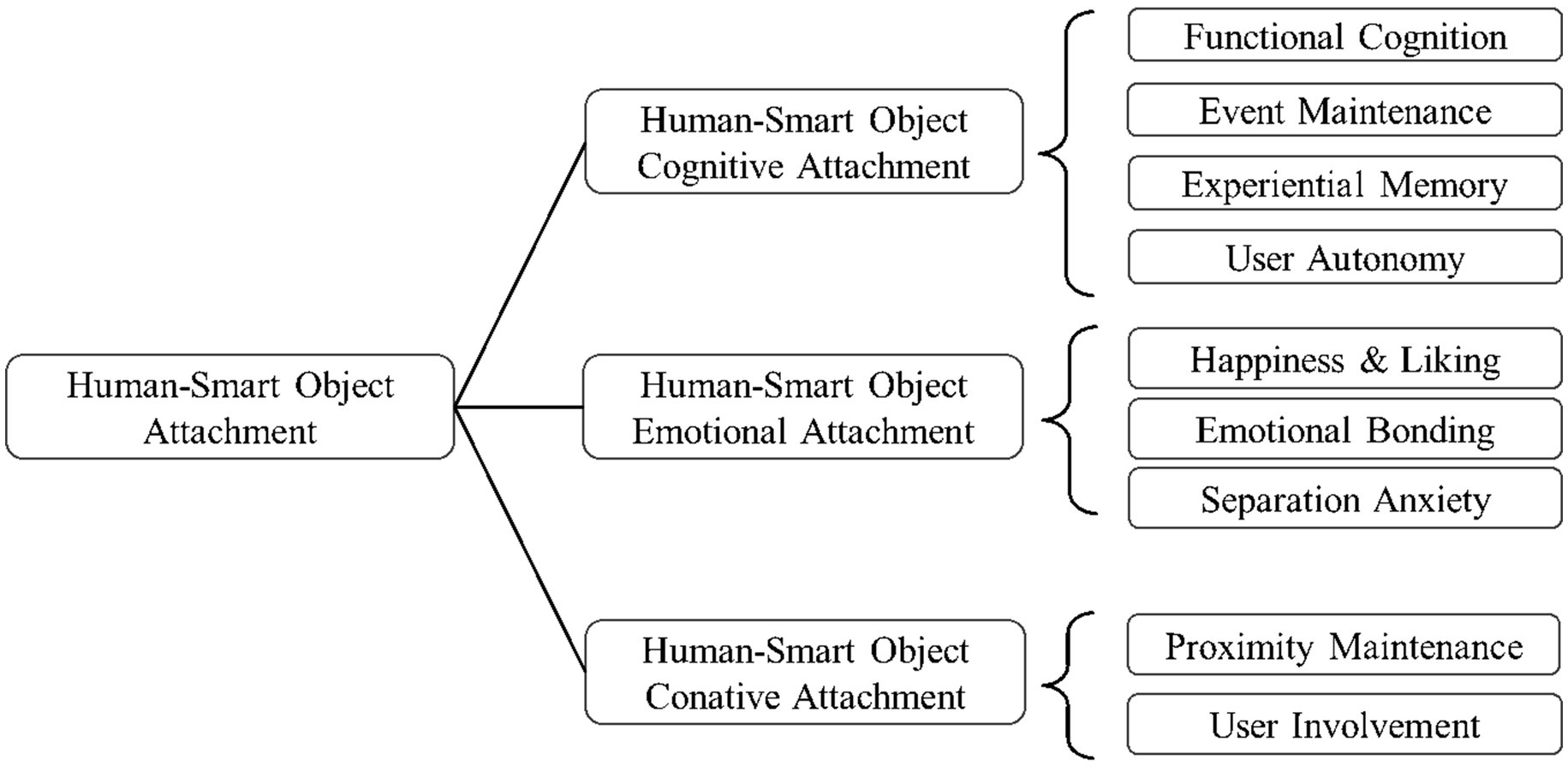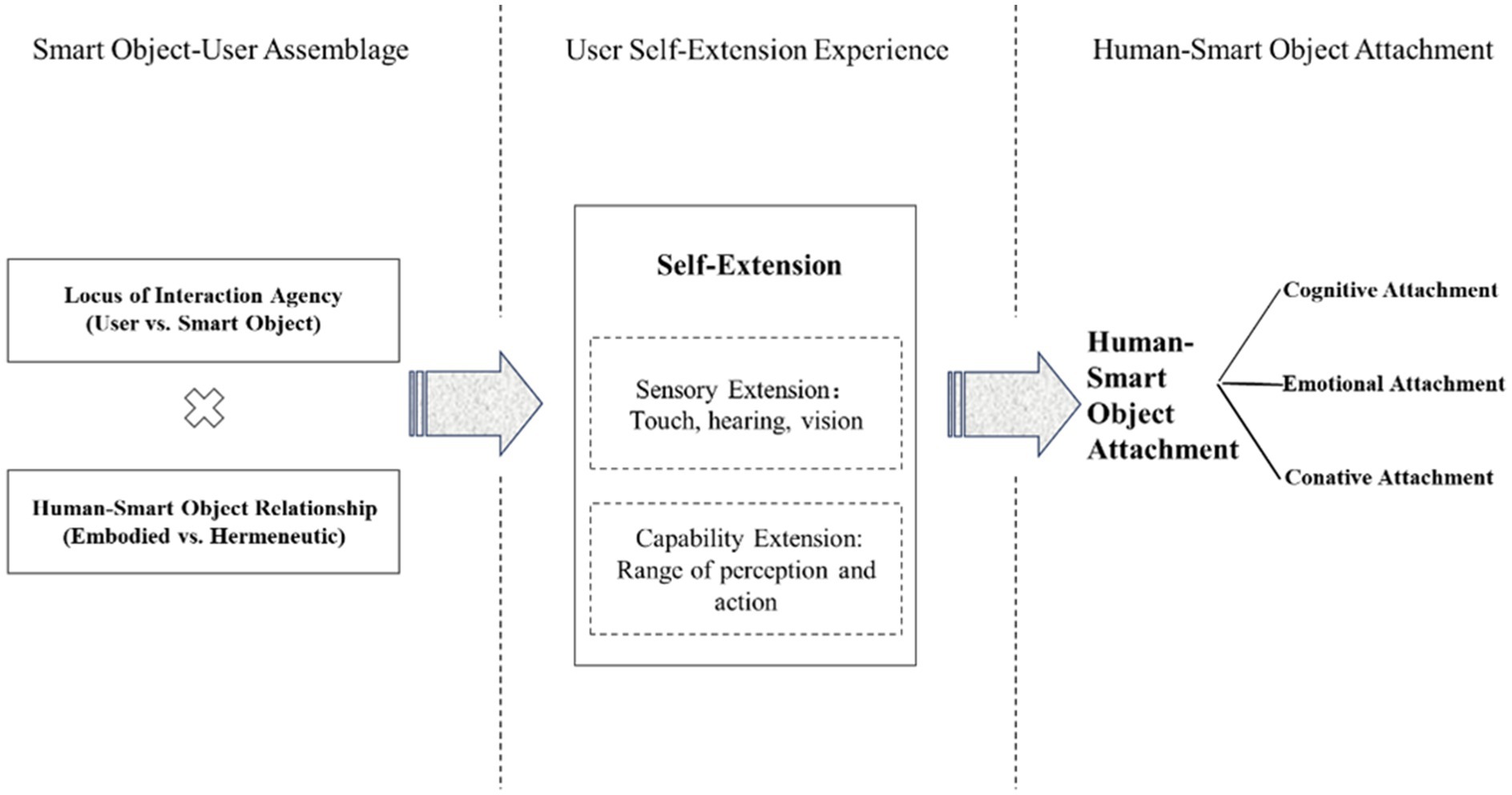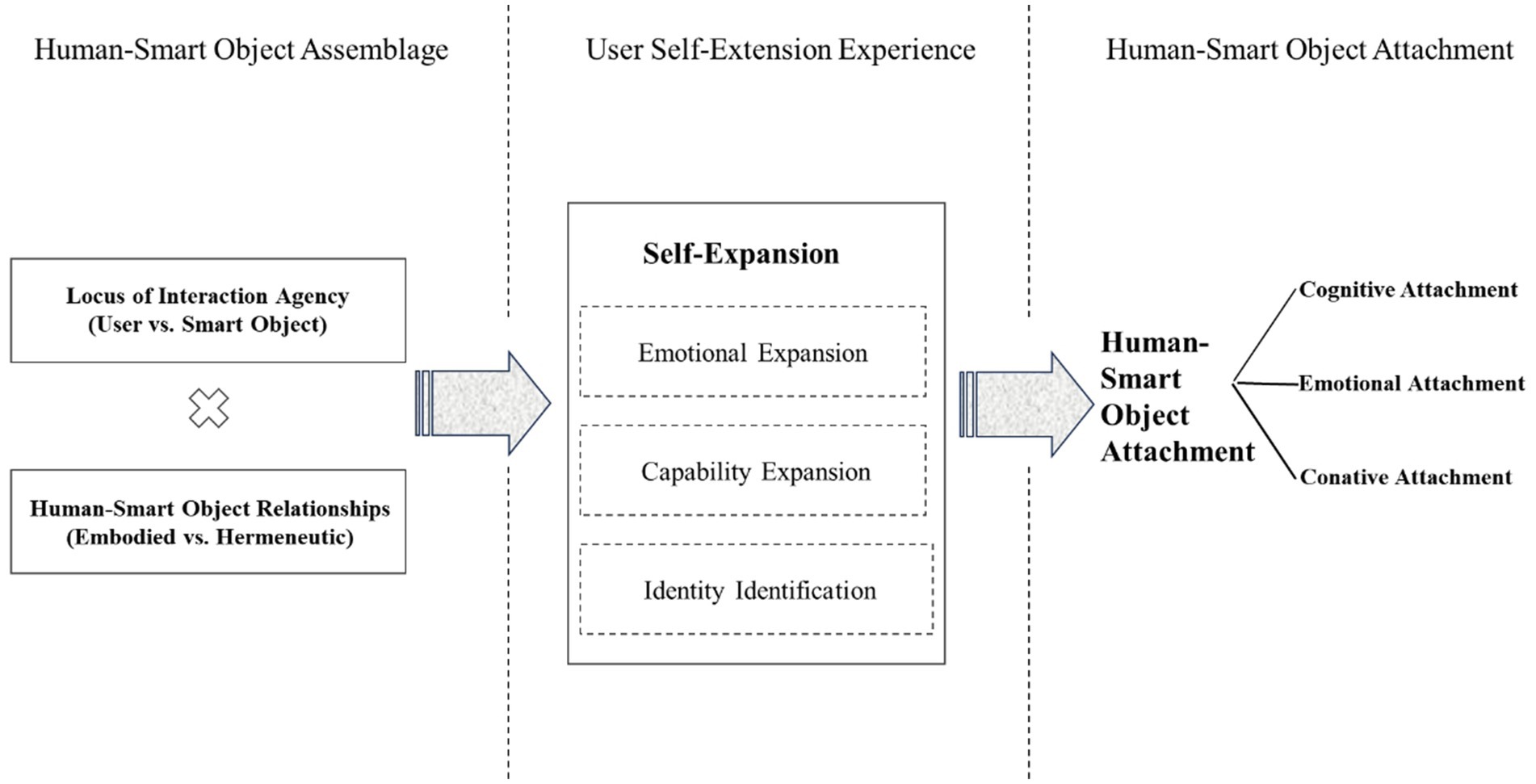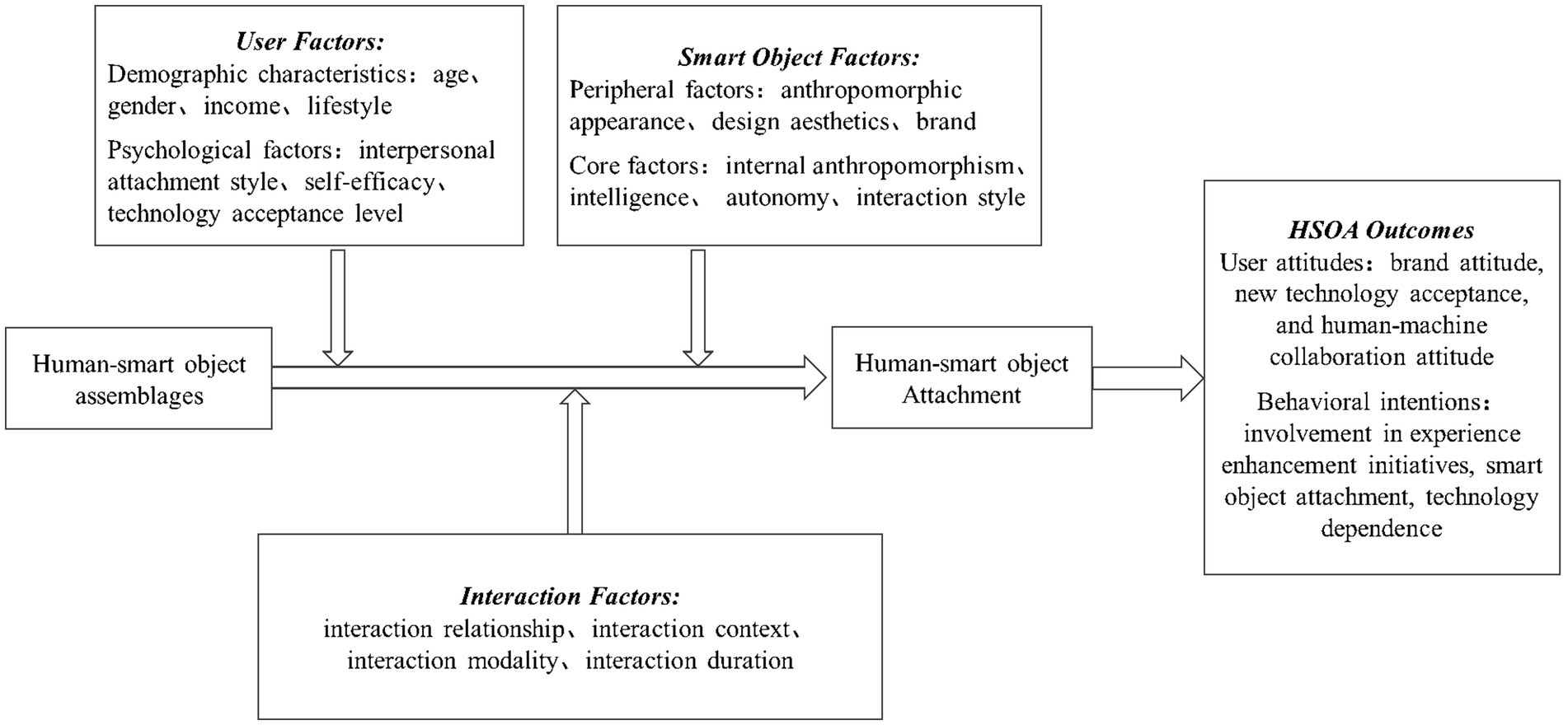- School of Management, Jinan University, Guangzhou, China
With the rapid development of artificial intelligence, the Internet of Things, and related technologies, human-smart object relationships have become increasingly diversified. As smart object become deeply embedded in human society, this has given rise to emerging ethical issues—particularly human-smart object attachment—whose characteristics and influencing pathways remain unclear. This study focuses on the context of wearable smart devices and adopts a two-stage mixed-methods approach: First, based on assemblage theory and existing literature, we construct a three-phase theoretical framework encompassing human-smart object assemblage formation, experience, and attachment. Subsequently, using grounded theory, we conduct in-depth interviews with users of wearable smart objects and employ a three-tier coding process to clarify the conceptualization, typology, and formation pathways of human-smart object attachment. The findings reveal that human-smart object attachment is essentially a psychological bond formed through “self-extension” and “self-expansion,” facilitated by human-smart object capability synergy. It encompasses cognitive, affective, and conative dimensions and is influenced by three key factors: the user, the smart object, and the interaction process. Furthermore, the study explores the impact of human-smart object attachment on user attitudes and behaviors. As a unique phenomenon, the complexity of human-smart object attachment calls for HCI scholars to adopt multidisciplinary perspectives to investigate its mechanisms and effects. Such insights can assist enterprises and communities in developing technology products that better align with user needs.
1 Introduction
With the rapid advancement of artificial intelligence, the Internet of Things, and related technologies, human-smart object relationships have become increasingly diversified as intelligent objects deeply integrate into various social domains, raising new ethical concerns. The widespread adoption of smart objects may result in fragmented sociotechnical landscapes, as users form varied bonds such as attachment, dependency, or even addiction. We also identified two key individual-level concerns. First, the datafication of the self results from quantifying users’ behaviors and emotions through extensive interaction with smart devices, which may restrict personal autonomy (Kristensen and Ruckenstein, 2018). Second, trust vulnerability arises when persuasive and anthropomorphic designs manipulate users’ emotional trust in systems whose intentions and limitations remain opaque (Hermann, 2022; Bamicha and Drigas, 2024). Investigating human-smart object relationships not only helps optimize user experience, innovate interaction paradigms, ensure data security, and clarify smart object moral responsibility, but also provides theoretical support for establishing social ethical norms. From a marketing perspective, this research holds dual value. At the practical level, it can guide enterprises in improving customer experience, enhancing personalized services, and achieving precision marketing. At the strategic level, it facilitates brand loyalty cultivation, promotes marketing innovation, and strengthens corporate market adaptability and social responsibility fulfillment.
Currently, human-smart object relationships have evolved from initial technology adoption to deep collaboration, and in some domains, even surpassed traditional human-dominant paradigms. This increasing complexity has given rise to phenomena such as user dependence, addiction, and human-smart object attachment toward intelligent devices. Existing literature indicates that human-smart object attachment, as a complex phenomenon in the field of human-computer interaction (HCI), involves emotional bonds between users and smart objects/technologies.
Although attachment theory has seen preliminary applications in HCI research in recent years, related explorations remain insufficient. As AI technologies increasingly demonstrate social attributes, their intelligent interaction capabilities have been shown to evoke users’ emotional expression and self-identity, presenting new theoretical opportunities for human-smart object attachment research. However, given current limitations in smart object intelligence, human-smart object relationships exhibit both similarities to and differences from interpersonal relationships. Academic research on core issues of human-smart object attachment—including conceptual definitions, constituent dimensions, influencing factors, and operational mechanisms—currently remains in its nascent stage.
Therefore, this study focuses on two key questions: (1) How to define the construct of human-smart object attachment? (2) How does human-smart object assemblage experience affect human-smart object attachment? The research adopts a qualitative paradigm. First, we integrate assemblage experience theory and attachment theory to build an analytical framework. Second, we collect content from social platforms and design/adjust interview protocols based on research questions to conduct in-depth interviews with wearable smart device users for primary data. Then we apply grounded theory to code the materials. Based on coding results, we first clarify the conceptual definition, categories, and developmental stages of human-smart object attachment. Next, we summarize the mechanisms through which human-smart object assemblage experience affects attachment, clarifying the internal processes and influencing factors. Finally, we identify potential consequent variables of human-smart object attachment in marketing contexts.
2 Literature review and research framework
2.1 Assemblage experience theory
The concept of “assemblage” was first proposed by French philosophers Deleuze and Guattari from the speculative realism school of philosophy (Gilman et al., 1989). Originally, it referred to a multiplicity formed by different terms that transcend essential boundaries and interconnect. Building upon this foundation, marketing scholars have reconceptualized assemblage theory. Hoffman, Novak, and others introduced it into consumer experience research, proposing the notion of “consumer-object experience assemblage” (Hoffman and Novak, 2015, 2018). An assemblage consists of heterogeneous components that continuously interact with each other and with other entities, ultimately forming a whole with new properties, capabilities, or tendencies.
2.1.1 Key component of assemblage theory
Components are the basic units that constitute an assemblage. They can be human or non-human, material or immaterial, organic or inorganic. The components exhibit heterogeneity while maintaining autonomy and independent identities within the assemblage. This means that the constituent parts can exist across assemblages or independently separate from the current assemblage. The relationships between components are dynamically evolving, potentially undergoing changes, substitutions, or reorganizations, thereby shaping different assemblages.
Properties represent the observable characteristics of an assemblage that can be enumerated to a limited extent (DeLanda, 2016). In product design, attributes include both surface-level elements (e.g., packaging, components, dimensions) and deeper-level characteristics that shape user experience. The properties of components directly influence the realization of an assemblage’s capabilities, which are divided into material capability and expressive capability. Material capability/role enables consumers or producers to physically interact with products in specific ways, such as a bridge supporting vehicles or shapewear altering body contours (Hargadon and Douglas, 2001; Martin and Schouten, 2014). Material capability significantly impacts consumers’ willingness to adopt new technologies, as it typically requires actual interaction between consumers and products. Expressive capability/role refers to an object’s ability to link with specific symbolic meanings within an assemblage. Components express certain meanings through their particular roles in the assemblage (Gilman et al., 1989). Expressive capability and material capability are not mutually exclusive; under certain conditions, they can transform into each other or coexist. For example, the color of bird feathers may initially serve functional purposes but can also acquire expressive significance when used to distinguish between different bird species.
Interactivity is the core of assemblage theory. The properties, capabilities, and developmental tendencies of components are manifested through capability matching during interaction processes. Without interaction, the assemblage would cease to exist. In addition to interactions between components, components can also interact with the entire assemblage, and interactions can occur between different assemblages (Martin and Schouten, 2014).
2.1.2 The relationship between consumers and smart objects in assemblage experience
Hoffman and Novak drew upon Pincus and Ansell’ s interpersonal circumplex model (Pincus and Ansell, 2003) to propose a consumer-object relationship circumplex model (Hoffman and Novak, 2018). This model categorizes interaction patterns between consumers and objects into four types based on two dimensions: agentic role and communal role: complementary master-servant relationship, non-corresponding master-servant relationship, partnership, and unstable relationship (Novak and Hoffman, 2019). These types reflect the degree of complementarity in expressive capability between consumers and objects, elucidating the interaction patterns between consumers and objects. With the rise of digital connectivity and ubiquitous computing, smart objects are increasingly conceptualized not as fixed or discrete entities, but as fluid and adaptive assemblages shaped by context and interaction (Redström and Wiltse, 2019). Thus, the consumer-object relationship is dynamic, evolving within the structure of the relationship circumplex model.
2.1.3 Outcomes of assemblage experience
According to assemblage theory, interactions occur through the mutual influence of capability matching between components, as well as between components and the whole. The components and whole involved in these interactions then generate new properties and capabilities. Hoffman suggests that these new capabilities may produce either positive impacts or negative outcomes, thus classifying experiences into enabling experience and constraining experience. Since consumers and objects may assume different expressive roles (either agentic or communal) during interactions, Hoffman integrates existing concepts to identify four types of consumer experiences: self-extension, self-expansion, self-restriction, and self-reduction (Hoffman and Novak, 2018), as shown in Figure 1.
Self-extension originally refers to how individuals project their identity onto meaningful objects, extending themselves to possessions and others (Belk, 1988). The realization paths include: first, consumers perceive and feel control over objects; second, consumers become accustomed to the objects’ presence and establish intimate relationships, incorporating the objects’ resources and capabilities into their self-concept. Therefore, the self-extension experience refers to consumers occupying an agentic role that enables the assemblage (Belk, 2013). Self-expansion stems from people’s tendency to expand their goal-achieving capabilities through close relationships (Aron and Aron, 1986). Thus, the self-expansion experience refers to consumers being empowered by the assemblage through a communal role. Self-restriction occurs when consumers assume an agentic position during interaction and have the capability to constrain the entire consumer-object assemblage, such as by removing components or terminating interactions, thereby weakening the assemblage’s capabilities. Self-reduction means consumers not only exhibit a communal role but are also constrained by the assemblage. Examples of these four types of human-smart object interaction assemblage experiences are presented in Table 1.
2.2 Differentiation of human-smart object attachment from related constructs and theories
2.2.1 Distinguishing nostalgia and human-smart object attachment
Attachment and nostalgia share both similarities and differences as psychological constructs. Their commonalities are reflected in two aspects: First, both involve emotional experiences—nostalgia represents emotional reminiscence of the past, while human-smart object attachment (hereinafter refers to HSOA) relates to emotional and other bonds formed through interactions with smart devices or robots. Second, both can serve as coping mechanisms for real-life stress—nostalgia provides comfort by recalling positive past experiences, while HSOA offers emotional support through human-smart object interaction.
Although nostalgia and HSOA may appear to share similarities in certain aspects, prior research indicates that nostalgia is a form of memory recognized as a key determinant of product attachment (Mugge et al., 2005). This suggests that nostalgia influences attachment, indicating a connection between the two concepts, however, there are fundamental distinctions between them in terms of temporal focus and interaction mechanisms.
Specifically, nostalgia is typically evoked by past-oriented reflection and is directed toward people, places, or moments from a former life stage. It serves to reinforce self-continuity and provide emotional comfort through memory recall (Muehling and Sprott, 2004; Mugge et al., 2005). In contrast, HSOA emerges from real-time, ongoing interactions with smart objects that possess embedded intelligence and agency (Novak and Hoffman, 2019). It is forward-facing and functional, shaped through dynamic user-object engagement, and reflects a user’s desire for immediate emotional support, enhanced capabilities, and personalized responsiveness (Hu et al., 2025). While nostalgia is largely passive and unidirectional in nature, HSOA is actively co-constructed through continuous, reciprocal interaction between the user and the smart object.
2.2.2 Distinguishing attachment, dependence and addiction
Attachment, dependence, and addiction all involve individuals’ repeated engagement with certain behaviors or substances, but they differ fundamentally. Addiction refers to persistent seeking and use of substances or behaviors despite negative consequences, where behavior shifts from purposeful instrumental use to uncontrolled habitual patterns (Chen, 2019). In human-smart technology interactions, the line between appropriate and problematic use often blurs, as smart device usage may evolve from efficiency/social enhancement to automated, uncontrollable addictive behaviors (Coffey, 2018). Dependence primarily reflects users’ trust in smart object performance and reliability assessments, emphasizing functionality and efficiency (Ainsworth, 1969). Attachment constitutes an emotion-based, enduring bond between users and smart devices/robots (Chen, 2019), arising from anthropomorphic perceptions, emotional involvement, and social interaction. In summary: attachment represents healthy emotional connections; dependence indicates over-reliance; addiction reflects uncontrollable cravings (Insel, 2003). Clarifying these distinctions helps address technology-related issues. While concepts like internet gaming disorder and smartphone addiction have emerged, AI-era smart objects with multiple properties exhibit complexities surpassing simple dependence/addiction frameworks (as shown in Figure 2).
2.3 The relationship between human-smart object experience and human-smart object attachment
Smart objects and users form interactive assemblages through their interactions, generating consumer/user experiences. These experiences differentiate based on actor properties and interaction modes, ultimately influencing various human-smart object relationships including HSOA. The rapid development of the Internet has laid the foundation for the intelligence of ordinary objects and the Internet of Things, giving rise to smart objects with enhanced interactivity and agency. Therefore, human-smart object interaction experiences should not be limited to traditional user-centered models. According to Hoffman’s assemblage theory (2018), the formation of HSOA involves at least two stages. The first stage consists of user-smart object interactions, where smart objects simulate human-like communication patterns through interactive interfaces and intelligent algorithms. Due to differences in users’ role perceptions and capability characteristics, the user experiences exhibit relative, dynamic and fluid properties. The second stage of human-smart object interaction may produce two distinct outcomes: enabling experiences (such as self-extension and self-expansion) that promote relationship deepening, while constraining experiences (such as self-restriction and self-reduction) may hinder attachment formation (as shown in Figure 3).
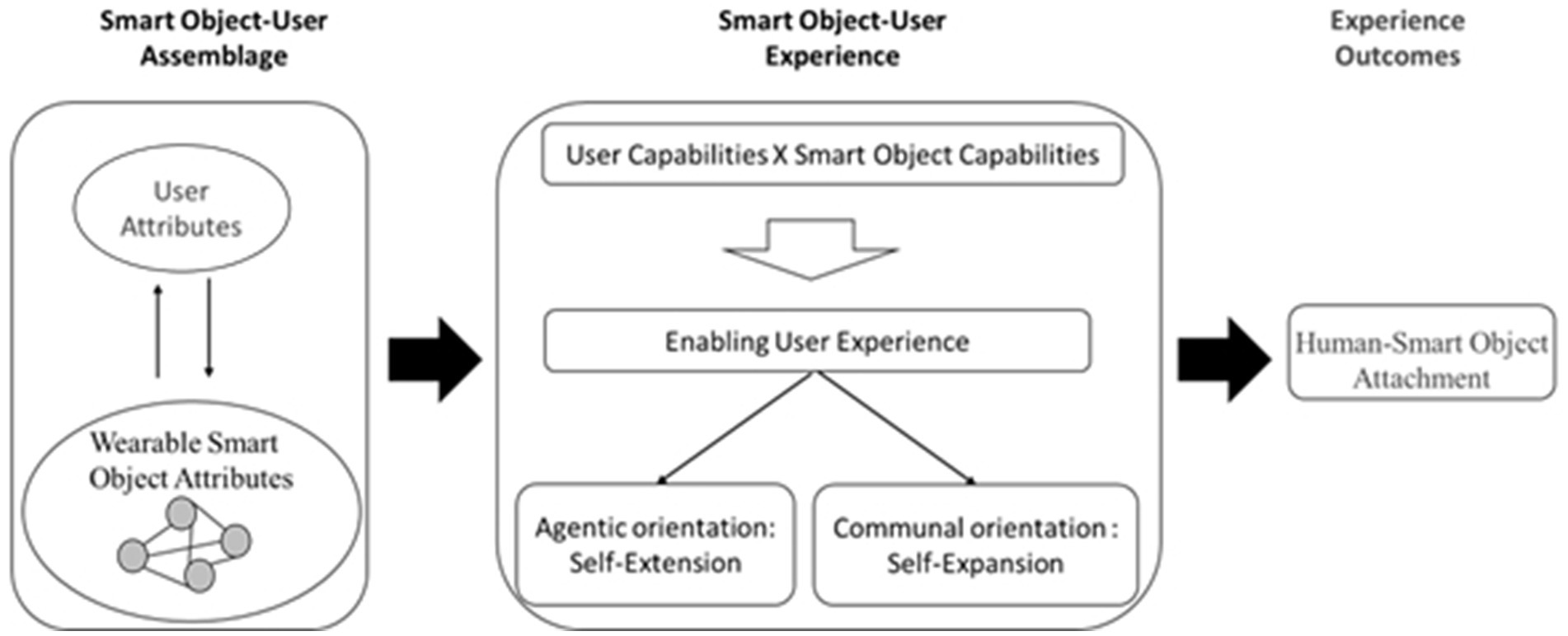
Figure 3. The mechanism of human-computer interaction experience affecting human-smart object attachment.
Notably, studies that demonstrate both stages and yield positive outcomes are particularly prominent in the fields of therapeutic care and health management. Research has shown that, compared with non-autistic individuals, wearable smart objects can alleviate stress perception, anxiety, and physiological arousal in individuals with autism. Through a meta-analysis, Pergantis et al. (2025) found that such devices help autistic individuals concretize abstract concepts, supporting their sequence memory, time management, and language comprehension. This assists users in developing self-awareness and expanding their self-concept, which has been associated with significantly reducing anxiety and alleviating stress responses.
In a similar vein, Torrado et al. (2017) embedded sensor systems into smartwatches to infer emotional fluctuations from physiological signals and movement patterns, employing personalized feedback strategies to enhance emotional self-regulation in autistic users. This not only improved emotional bonding but also strengthened their willingness to engage with the devices. Reeder and David (2016), in a systematic review of health and behavioral monitoring via smartwatches, highlighted the advantages of these devices in self-monitoring, real-time feedback, and bidirectional communication between users, families, and healthcare providers. Such capabilities contribute to the construction of a “quantified self,” rendering the self-concept more dynamic and contextualized, and facilitating self-extension.
In the context of social robotics, Bamicha and Drigas (2024) found that intelligent robots equipped with theory of mind capabilities can accurately perceive and respond to users’ intentions and emotions. Users often perceive the robot’s cognitive abilities as an extension of their own, experiencing the robot as an “internal assistant.” According to Belk (2013), this experience can blur the boundary between self and other. Moreover, the metacognitive feedback provided by these robots—such as prompting reflection on blind spots and offering strategic suggestions—allows users to internalize the robot into their decision-making process. This integration positions the robot not only as a tool of self-extension but also as a component of the user’s metacognition. Over time, users adopt new self-monitoring and self-regulation strategies through these interactions, expanding their cognitive and emotional capabilities. These findings underscore how anthropomorphic communication design in smart objects can enhance empathy and trust in human-machine relationships via both self-expansion and self-extension, ultimately improving user experience.
Attachment theory posits that individuals develop internal working models concerning the self, the attachment object, and their relationship. In human-smart object relationships, people form internal working models based on their interactive experiences with smart objects, which influence their expectations and behaviors in subsequent human-smart object interactions. Interactive experiences facilitate the formation of various human-smart object relationships, among which HSOA is one notable example. This emerging form of attachment in the new era context further impacts users’ in-depth usage experiences and consumption behaviors.
2.4 Wearable smart object
To explore human–smart object interactions, this study adopts wearable smart objects as a representative case, guided by three main rationales.
First, wearable smart objects have wide-ranging applications and strong practical relevance. Currently, wearable devices are most prominently used in the fields of healthcare, fitness, and entertainment. In smart healthcare, wearable technologies play a crucial enabling role by leveraging intelligent terminals, mobile communication, and cloud computing to provide remote health services (Dias and Cunha, 2018; Islam et al., 2015). In the fitness domain, wearable devices equipped with motion and biosensors—such as smartwatches and fitness trackers—can monitor physical activity, caloric consumption, heart rate, and sleep quality in real time, making them highly suitable for goal tracking and health management (Piwek et al., 2016; Patel et al., 2012). These devices are the most widely adopted forms of wearable smart technology and have been applied in various contexts, including posture correction, muscle training, exercise data collection, risk assessment, and performance optimization.
Second, wearable smart objects exhibit relatively high consistency in their technological architecture. As Gao et al. (2015) noted, most devices incorporate three core capabilities: environmental sensing, data processing, and responsive feedback. These functions are typically supported by standardized components such as multi-modal sensor arrays, short-range wireless protocols (e.g., Bluetooth, NFC), and cloud-based analytics infrastructures (Lee et al., 2015). This architectural uniformity not only facilitates seamless user experiences but also enables systematic theoretical modeling and empirically grounded analysis.
Third, their hybrid physical–digital nature creates distinctive conditions for emotional attachment formation. In addition to functional affordances such as interactivity and personalization, wearable smart objects embody physical characteristics—such as aesthetic design, wearability, and tactile comfort—that deepen user engagement (Kalantari, 2017). Empirical research confirms that visual appeal significantly influences perceived value and user satisfaction (Yang et al., 2016), while habitual usage patterns are positively associated with attachment strength (Sung et al., 2007; Huber et al., 2016). Given their persistent bodily proximity and high interaction frequency, wearable smart objects provide an ideal context for exploring the formation and evolution of human–smart object attachment (HSOA).
Based on these considerations, wearable smart objects provide both theoretical significance and empirical richness, making them an analytically tractable and conceptually meaningful focus for exploring the formation and mechanisms of HSOA.
3 Research design
3.1 Methodology
This study adopts grounded theory to explore the formation pathways of HSOA and its antecedents and consequences. Grounded theory systematically induces theories from empirical data through standardized procedures. The adoption of this method is based on three considerations: (1) The concept of HSOA lacks consensus and mostly remains superficial (Gillath et al., 2021), making grounded theory more suitable for revealing its essence and impacts; (2) Grounded theory excels at analyzing influencing processes (Eisenhardt, 1989), facilitating the examination of the evolutionary process of attachment between users and smart objects, and clarifying the experiences and factors affecting attachment formation, as demonstrated by Murmann who used grounded theory to discuss the co-evolutionary process between industries and environmental factors and their influencing elements (Murmann, 2013); (3) Grounded theory can effectively handle multivariate relationships in complex dynamic social phenomena, uncovering the intrinsic mechanisms of human-smart object relationships (Yin, 2016). Given this study’s need to develop conceptual understanding and address related issues, we employ the qualitative analysis method of grounded theory, which includes core processes of data collection and coding.
Through in-depth interviews, primary data is collected. The interview content is then coded with reference to relevant literature to extract the meaning, dimensions, process elements, developmental stages, and antecedents and consequences of HSOA.
3.2 Theoretical sampling
This study employs theoretical sampling with four primary criteria: accessibility, suitability, typicality, and sample size. Young adults who frequently use smart devices in their daily lives were selected as participants. There are no fixed standards for sample size in theoretical sampling; sampling ceased when new data no longer yielded novel insights or categories. Ultimately, 27 participants from various industries, all with experience using wearable smart devices (either past or current), were selected for semi-structured interviews. All interviewees used wearable smart devices for more than 1 h daily, with a balanced gender ratio (44.44% female). The majority held bachelor’s degrees or higher. The devices used included smartwatches, fitness trackers, smart glasses, smart earphones, and VR/AR headsets.
The researchers continuously adjusted the interview guide and theoretical framework based on the interview results until theoretical saturation was achieved. The specific procedures were as follows: First, participants who had used smart objects were recruited and screened, and discussions were conducted focusing on “human-smart object attachment relationships,” including the participants’ personal information and overview of smart object usage. Ultimately, a total of 27 interview transcripts were collected. The duration of individual interviews ranged from 10 to 90 min, with an average interview time of approximately 25 min. The total interview duration was 12.8 h, and the transcribed text amounted to approximately 280,000 characters. Table 2 provides detailed information about the respondents’ basic characteristics.
3.3 Data collection
3.3.1 Semi-structured interviews
The interview outline aims to collect data on HSOA through semi-structured interviews, focusing on smart device usage experiences and emotional connections. The interview content ranges from collecting basic information to in-depth exploration of attachment feelings and influencing factors.
To ensure sample diversity, interviewees include users of different smart devices, those at different usage stages, those who have lost or replaced smart objects, and those who have recovered lost devices. Specific interview questions include: understanding respondents’ smart object usage profiles (including device types, frequently used devices, ownership status and duration of use); exploring respondents’ perceptions of smart objects (including characteristics, differences from ordinary objects, and usage experiences); understanding respondents’ views on HSOA (including differences between attachment and other concepts, manifestations of attachment, and influencing factors); discussing post-attachment dynamics (such as the impact of separation, loss, replacement, technological upgrades, etc. on attachment); and examining smart object agency and its influence on HSOA. The influence of factors such as interaction distance, interaction methods, and brand effects on attachment are also considered.
After the interviews, recordings are transcribed into text, with content differentiated between interviewer and interviewee. The distinction between main questions and follow-up questions is also considered, analyzing their impact on the results.
3.3.2 Online materials
This study analyzes “human-machine attachment” discourse from three Chinese social platforms: Douban, Weibo, and Zhihu. For example, the Media Development Research Center of Wuhan University noted that members of the “Human-smart object Romance” group on Douban share interaction experiences, seek help, and exchange insights.
Additionally, relevant literature was obtained from academic databases, along with news articles and research reports, to understand both public and expert perspectives on this phenomenon.
3.4 Data coding and analysis
This study adopted a tri-level iterative coding analysis: (1) data cleaning and organization; (2) analysis and expression; (3) conclusion verification and model revision, until theoretical saturation was achieved.
The research utilized NVivo 11 Plus for three-level node coding, with multiple reviewers involved to reduce coding bias. The specific procedure was as follows: (1) Basic coding: extracting information sentence-by-sentence from 27 interviews to form third-level nodes; (2) Node induction: consolidating third-level nodes into second-level nodes; (3) Category integration: refining second-level nodes into first-level nodes to construct a complete coding system (Table 3). The first-level nodes primarily covered four dimensions: conceptual connotation of HSOA, influencing pathways, outcome effects, and influencing factors.
3.4.1 Open coding
This study conducted detailed textual analysis using NVivo 11 Plus (Zamawe, 2015), initially identifying 166 concepts related to human-smart object emotional dependence. Due to issues of repetition and dispersion among these initial concepts, the research team decided to retain only those concepts that appeared three times or more during the process of theoretical sampling and coding. When eliminating redundant concepts, a team cross-validation mechanism was employed, where coding consensus was reached through discussion before proceeding to the next stage of analysis. Ultimately, 31 open codes that met the requirements of typicality, accuracy, and relevance were formed, as shown in Table 4.
3.4.2 Axial coding
Axial coding is an analytical process that involves screening, summarizing, and categorizing concepts based on open coding. The research team conducted in-depth induction and organization of the 31 concepts obtained through open coding, integrating these concepts with existing research findings on HSOA. Through this process, three subcategories closely related to the concept of “human-smart object attachment” were ultimately refined, including functional cognition, event maintenance, human-smart object independence, experiential memory, happiness and liking, emotional connection, separation anxiety, user involvement, and proximity maintenance. These subcategories possess higher representativeness and can integrate and extract initial concepts. Furthermore, six additional subcategories involve variables that influence human-smart object relationship experiences, such as human factors, wearable smart device factors, and human-smart object interaction factors, as well as potential outcome variables that may arise from HSOA.
3.4.3 Selective coding
Through comprehensive comparison and analysis of open coding and axial coding results, along with referencing existing research on attachment in the field of artificial intelligence (Gillath et al., 2021; Hertlein and Twist, 2018), this study ultimately constructed the structural dimensions of HSOA with “cognitive attachment,” “emotional attachment,” and “conative attachment” as the core. The interaction assemblage between smart objects and users forms the starting point of the relationship. The experiences (constraining/enabling) generated through their interactions promote attachment formation via mechanisms of self-expansion (agentic) or self-extension (communal).
Selective coding revealed that HSOA primarily forms through enabling experiences (self-extension and self-expansion) rather than constraining experiences (e.g., self-reduction and self-restriction), with its core lying in the exertion of user agency. Enabling experiences strengthen self-cognition and extend user perception by enhancing user capabilities (e.g., smart tools improving efficiency) and expanding identity roles. In contrast, constraining experiences hinder the establishment of HSOA by undermining user autonomy (e.g., forced operational processes) or reducing perceived competence (e.g., overreliance leading to skill degradation). Enabling experiences directly foster attachment by enhancing “user agency,” while constraining experiences lack such connections. The study systematically elucidates the definition, types, dimensions, developmental stages, and outcomes of attachment, highlighting that this process is moderated by three factors: smart object characteristics, user traits, and interaction contexts (as illustrated in Figure 4).
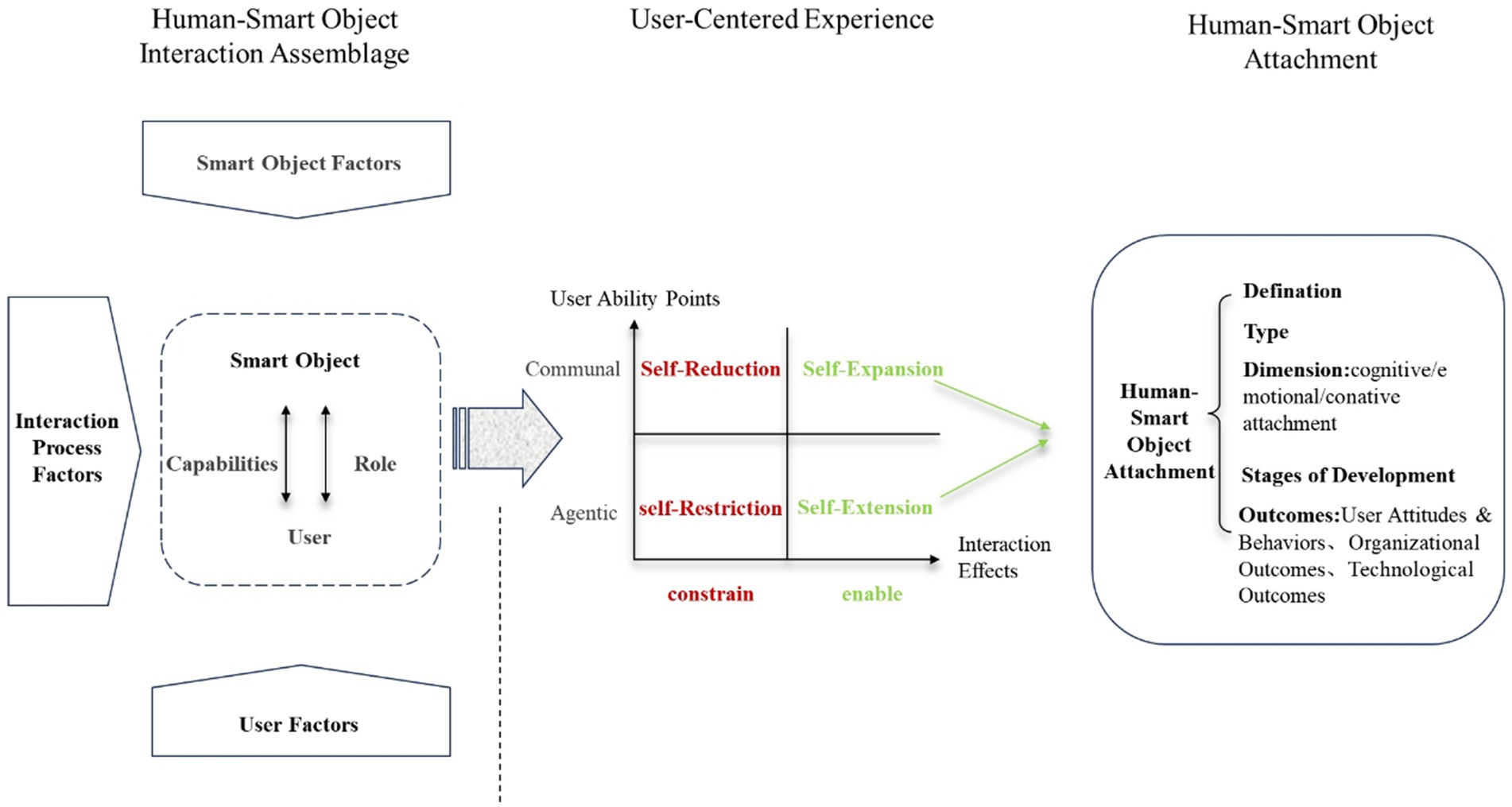
Figure 4. Path model of human-smart object assemblage experience affects human-smart object attachment.
3.4.4 Saturation test
This study verified theoretical saturation through three approaches: supplementary interviews, literature comparison, and expert consultation. The results showed that no new categories or relationships were identified regarding the concept of HSOA, indicating the theoretical model had reached saturation. The finalized three-dimensional structure of HSOA consists of: cognitive attachment, emotional attachment, and conative attachment. Consequently, this paper defines “human-smart object attachment” as a relationship between users and wearable smart objects that transcends purely functional use, forming long-term emotional bonds and corresponding behavioral tendencies. To visually present the research findings, a word cloud of HSOA was generated based on high-frequency keywords (as shown in Figure 5).
4 Mechanism of human-smart object assemblage experience on human-smart object attachment
4.1 Components and internal relationship of human-smart object attachment
HSOA refers to the emotional bond formed between users and smart devices, which is particularly significant in the context of wearable smart devices. HSOA comprises three dimensions: human-smart object cognitive attachment, human-smart object emotional attachment, and human-smart object conative attachment. These three dimensions and their constituent elements are illustrated in Figure 6.
4.1.1 Human-smart object cognitive attachment
Human-smart object cognitive attachment, as the foundational dimension of HSOA, contains four core elements: functional cognition, event maintenance, experiential memory, and human-smart object independence. Specifically: functional cognition reflects users’ recognition of a device’s functional value, such as how a smartwatch’s health monitoring features improve quality of life (A22-09); event maintenance manifests when devices become deeply integrated into users’ daily affairs, such as smart devices establishing psychological connections through functions like schedule reminders (A5-09); experiential memory refers to emotional memories accumulated during use, such as fitness trackers preserving users’ achievement experiences (A24-14); human-smart object independence emphasizes users maintaining autonomy while enjoying device convenience, such as users retaining traditional information acquisition methods while using smart glasses (A27-15). These elements together constitute users’ cognitive evaluation system for smart devices.
4.1.2 Human-smart object emotional attachment
Human-smart object emotional attachment refers to the emotional connection and dependence that users develop toward smart devices, representing the core of establishing HSOA. It manifests through three key elements: First is happiness and liking, which refers to users’ affection and pleasure derived from a device’s appearance design, functional performance, and usage experience. For example, both the fashionable design and accurate health monitoring features of a smartwatch can evoke users’ positive emotions (A16-11). Second is emotional bonding (Thomson et al., 2005), referring to users’ emotional fluctuations triggered during device interactions. When devices provide positive feedback, users feel satisfied, whereas functional failures may cause anxiety, indicating that the human-smart object relationship has transcended purely functional use. Finally, separation anxiety (Manicavasagar et al., 2003) describes users’ unease when separated from highly personalized wearable devices, a reaction that confirms the device has become an indispensable part of users’ lives (A11-14).
4.1.3 Human-smart object conative attachment
Human-smart object conative attachment reflects the behavioral interaction patterns between users and smart devices, containing two key behavioral characteristics: First is proximity maintenance, manifested by users’ tendency to wear devices closely or keep them within easy reach (Lei and Wu, 2007), where this spatial proximity need reflects attachment tendencies at the behavioral level, with typical cases including users promptly recharging drained fitness trackers to ensure continuous device availability; Second is user involvement, referring to the time and effort users actively devote to optimize usage experiences (Michaelidou and Dibb, 2008), where such involvement behaviors are reflected both in functional exploration, such as participating in fitness challenges and sharing data (A18-07), and in attention to appearance and performance, with the degree of involvement directly mapping the intensity of users’ attachment. These two behavioral dimensions together constitute observable external manifestations in human-smart object relationships.
4.2 Internal relationships of human-smart object attachment
In the context of wearable smart devices, the three dimensions of HSOA demonstrate dynamic interconstructive relationships. First, human-smart object cognitive attachment serves as the foundation for emotional and conative attachment, where users’ cognitive evaluations of devices directly influence their emotional and behavioral attachments. For example, when users perceive smart devices as having positive impacts on their lives, they are more likely to develop affection and pleasure toward the devices (A22-10). Second, emotional attachment represents the core, as users’ emotional connections with smart objects reinforce both cognitive and conative attachments. When users establish strong emotional bonds with smart devices, they tend to maintain closer proximity and invest more time and effort in exploring device functionalities (A03-21). Finally, human-smart object conative attachment provides feedback to cognitive and emotional attachments. Users’ behavioral tendencies and involvement levels reciprocally influence their cognitive perceptions and emotional bonds with devices. For instance, frequent device usage and dedicated involvement can enhance users’ cognitive recognition and dependence on devices (A09-18).
In wearable smart device contexts, HSOA constitutes a complex, multidimensional concept. By thoroughly understanding its connotations, dimensions, and internal relationships, we can better comprehend human-smart device interactions. While human–smart object attachment (HSOA) is commonly linked to pleasure, emotional satisfaction, and subjective well-being (Desmet and Pohlmeyer, 2013; Hassenzahl, 2010), recent studies emphasize additional mechanisms such as symbolic identification and relational maintenance. Anthropomorphic features can foster empathy and social connectedness (Purington et al., 2017), whereas, personalization and self-representative interfaces facilitate identity projection (Belk, 2013). Furthermore, ritualized interactions (Forlizzi, 2007) and trust-enhancing system behaviors (Luger and Sellen, 2016) further contribute to attachment by supporting symbolic continuity and relational stability. Collectively, this evidence suggests that HSOA is a multi-dimensional phenomenon. Taken together, these findings underscore the multidimensional nature of HSOA and offer valuable insights for the design and development of smart devices. Specifically, the internal relationship encourages a holistic approach that integrates functional cognition, emotional bonding, and behavioral patterns into both software and hardware design. These findings suggest that considering users’ higher-level needs through systematic design can effectively form HSOA.
In wearable smart device environments, the three dimensions of HSOA interact synergistically to form a complete attachment relationship. Therefore, this study defines “human-smart object attachment” as: Within human-smart object interactive assemblages, users’ cognitive perceptions of smart objects transcend purely functional use, forming long-term emotional attachments while demonstrating behavioral intentions to maintain proximity with and invest in the smart objects.
4.3 Mechanism of human-smart object assemblage’s influence on attachment
According to assemblage experience theory, the key factors in human-smart object interaction assemblages are user roles and capabilities. First, user roles are determined by the locus of agency (Kang and Kim, 2020a). The locus of agency originates from “locus of control,” reflecting an individual’s tendency to attribute responsibility to themselves or external factors. In HCI, the locus of agency specifically refers to the attribution of behavioral initiation and control rights during interaction. When users master the locus of agency, it means they control the interaction process and play an agentic role; conversely, if the locus of agency transfers to smart objects, it means smart objects dominate the interaction, and users correspondingly transform into communal roles. In short, the locus of agency reveals the key influence of user agency and sense of control on interaction experience. Second, capabilities in human-smart object interaction are presented through the relative relationship between the two. Don Ihde’s classification of relationships among humans, smart objects and environment mainly includes embodiment relations and hermeneutic relations (Martin and Schouten, 2014). Embodiment relations refer to smart objects integrating into user experience and becoming tools for perceiving the world. Hermeneutic relations emphasize technology’s role in understanding the world, where technology is not only a tool but also a medium helping users perceive and understand the world through limited perception.
4.3.1 Human-smart object assemblage interaction affects human-smart object attachment through self-extension
In human-smart object interaction, when the human-smart object relationship is an embodiment relation, self-extension experience becomes an important pathway for forming HSOA As shown in Figure 7, in embodiment relations, users’ senses interact with the environment through technology, making technology an extension of the body (Feenberg and Philosophy Documentation Center, 2003). Wearable smart objects extend users’ perceptual capabilities through vision, touch, hearing, etc. For example, smart glasses extend visual capabilities (A27-10), smart headphones enhance auditory perception (A23-08), and smart gloves improve tactile sensitivity.
When users master the locus of agency, they can actively control smart devices, making them natural extensions of bodily functions. Users can customize device functions according to personal needs (such as adjusting headphone noise cancelation modes), personalize device appearance (such as changing smartwatch straps), and enhance bodily perception and self-confidence through technologies like VR devices or exoskeleton robots.
Based on the above reasoning, wearable smart objects promote HSOA through embodiment relations. First, the convenience brought by sensory extension forms the foundation of cognitive attachment; second, anxiety caused by device damage or loss strengthens emotional attachment; finally, the sense of achievement from devices helping users achieve goals enhances willingness to use, manifesting as clear conative attachment tendencies.
In summary, in embodiment relations, when the locus of agency lies with users (Kang and Kim, 2020b), wearable smart objects expand users’ perception and action capabilities through self-extension experiences, thereby promoting the formation of HSOA.
Inference 1: Human-smart object interaction assemblages influence the formation of HSOA through self-extension. Specifically, through two pathways—sensory extension and capability extension—they, respectively, strengthen the three dimensions of cognitive attachment, emotional attachment, and conative attachment.
4.3.2 Human-smart object assemblage interaction affects attachment through self-expansion
Unlike “self-extension,” “self-expansion” focuses more on individuals expanding their self-concept through external resources (such as others or new experiences), typically not directly involving embodiment relations (Stenseng et al., 2012), but more related to hermeneutic relations. When the human-smart object relationship is hermeneutic, users tend to explore and understand the world through smart objects rather than merely extending capabilities (Ihde, 1999). This process helps users establish cognitive and emotional connections with smart objects, promoting self-expansion experiences. Individuals view themselves as part of a “user-smart object” community, where the self-concept transcends physiological and psychological boundaries, extending to systems composed of smart objects and other related elements. In the communal role, human-smart object relationships tend toward cooperation rather than control, with users incorporating smart objects into their self-concept based on shared experiences and understanding, thereby achieving deep attachment.
Through interactions with smart objects, users acquire new knowledge, gain new perspectives, and expand their self-concept (Chen et al., 2024), facilitating HSOA. For instance, smart health assistants can foster capability expansion by helping users build knowledge and confidence in self-management (Bickmore et al., 2005). Emotionally responsive AI agents such as smart speakers promote emotional expansion by simulating companionship and empathy in user interactions (Purington et al., 2017). Additionally, wearable technologies that support social comparison and community participation contribute to identity expansion, encouraging users to adopt and internalize new social roles (Kristensen and Ruckenstein, 2018). In terms of emotional attachment, users achieve emotional resonance by incorporating smart objects into self-actualization; regarding cognitive attachment, users enhance self-efficacy through collaborative task completion; for conative attachment, users expand their self-concept through smart health devices and online communities, further identifying with community members to achieve deeper self-expansion.
In summary, in HCI, when the locus of agency lies within the communal role, interactions between users and smart objects are based on shared experiences, forming self-expansion experiences rather than self-extension. Self-expansion emphasizes expanding self-cognition and emotion through smart objects, while self-extension focuses more on user control and utilization of smart objects, as shown in Figure 8.
Inference 2: Human-smart object interaction assemblages influence HSOA through self-expansion. Specifically, this manifests through three pathways of self-expansion—emotional expansion, capability expansion, and identity identification—which, respectively, strengthen cognitive attachment, emotional attachment, and conative attachment.
4.3.3 Parallel path of user self-extension and self-expansion in human-smart object attachment
Human-smart object interaction assemblages influence HSOA through two parallel mediators—self-expansion and self-extension—which also interact with each other, as shown in Figure 9.
Wearable smart devices provide users with rich functionalities and experiences through diversified human-computer interaction methods, thereby promoting users’ self-expansion and self-extension. For instance, smart fitness monitors collect exercise data through sensors (human-smart object interaction assemblage) to help users understand their physical condition and set fitness goals, thereby enhancing health management capabilities (self-expansion). During prolonged use, users gradually regard the fitness monitor as an indispensable part of their exercise routine, developing a sense of bodily extension (self-extension). This dual experience ultimately leads users to develop emotional dependence on the device, forming stable HSOA. Another example is smart headphones that enhance auditory experience through audio processing technology (self-expansion), which users may come to perceive as part of their auditory system after long-term use (self-extension), thereby developing strong emotional attachment (A23-16).
Moreover, self-expansion and self-extension mutually reinforce each other during user-device interactions (Belk, 2024). For example, smart glasses with augmented reality (AR) functionality help users obtain work information (self-expansion), while users gradually perceive them as extensions of their visual and cognitive systems (self-extension) (A25-12). As dependence deepens, users further explore device functions to achieve continuous capability expansion (A27-12).
In summary, in the context of wearable smart devices, human-smart object interaction assemblages influence the formation of HSOA through two parallel mediating pathways—self-expansion and self-extension. These processes represent both direct outcomes of user-device interaction and continuously deepen attachment through mutual reinforcement, providing important foundations for product design and user experience optimization.
Inference 3: In the mechanism through which human-smart object interaction assemblages affect HSOA, self-extension and self-expansion can form parallel pathways that jointly influence the formation and development of HSOA (Hu et al., 2025).
4.3.4 Moderating factors in the relationship between human-smart object assemblage experience and attachment
First, user factors influence human-smart object interaction assemblages and HSOA relationships, primarily including demographic characteristics and psychological factors. From demographic characteristics, users of different ages, genders, incomes, and lifestyles have varying needs and expectations for human-smart object interaction. Regarding psychological factors, users’ interpersonal attachment styles, self-efficacy, and technology acceptance levels determine how and to what extent they interact with smart objects (Rane et al., 2024). Specifically, younger users with higher acceptance of new technologies prefer fashionable and innovative interaction methods, while older adults focus more on health monitoring functions (age); consumers’ lifestyles (e.g., exercise habits, work nature) also affect the frequency of wearable device usage, with fitness enthusiasts using exercise monitoring functions more frequently and office workers tending to use notification and management functions (A13-15); users’ attachment styles and self-efficacy also influence their acceptance and dependence on wearable devices, with existing research showing that customers with anxious attachment styles respond more positively to frontline service robots; consumers with high self-efficacy may more readily accept new technologies and develop stronger attachment.
Second, smart object factors moderate the relationship between human-smart object interaction assemblages and HSOA. Smart object factors include peripheral factors and core factors (Knop et al., 2022). The former encompasses anthropomorphic appearance, design aesthetics, and brand, which can attract users. Anthropomorphic appearances increase closeness, exquisite designs draw attention, and fashionable designs enhance wearing willingness. Devices from well-known brands typically gain user trust, thereby increasing loyalty and attachment intensity. Core factors such as internal anthropomorphism, intelligence, autonomy, and interaction style directly affect users’ long-term experiences. Interaction designs that simulate human behavior and emotions make users feel the device has a “mind” (Hermann, 2022). When devices meet users’ interaction expectations, trust develops and attachment gradually forms. Meanwhile, devices’ autonomous capabilities actively solve user problems, further deepening dependence (A26-14). Simple and easy-to-operate interaction methods improve experience fluency, influencing users’ attachment feelings. Peripheral and core factors work together by affecting users’ emotional and cognitive responses, thereby influencing HSOA.
Finally, human-smart object interaction factors significantly moderate the relationship between human-smart object interaction assemblages and HSOA. Human-smart object interaction factors include interaction relationships, interaction contexts, interaction methods, and interaction time. Friendly interaction relationships, appropriate interaction contexts, convenient interaction methods, and reasonable interaction time all affect user experiences (Ahsanullah et al., 2006). For example, smartwatches influence the device’s capture of user information through touch operations and voice interactions, thereby affecting users’ attachment intensity (A16-17); in sports contexts, smart running shoes (e.g., HOVR Sonic 1.0) record metrics like pace and step count, helping users achieve self-expansion, making attachment more likely to form (A24-19).
Inference 4: In the pathway through which human-smart object interaction assemblages affect human-smart object interaction, the process is moderated by three factors: user factors, smart object factors, and human-smart object interaction factors.
4.3.5 Outcomes of human-smart object attachment
HSOA subsequently influences users’ attitudes, intentions, and behaviors. User attitudes include brand attitude, new technology acceptance, and human-smart object collaboration attitude (as shown in Figure 10). When users develop HSOA, they typically form favorable impressions of the brand and establish psychological connections with it (Yim et al., 2024). For example, Apple Watch users who develop affection and dependence on the product often exhibit higher brand loyalty and more positive attitudes toward the brand’s new technologies (A14-25). Additionally, HSOA can enhance users’ attitudes toward human-smart object collaboration (Read et al., 2011). When respondents are attached to their smart bands, they actively configure and use new features while paying attention to how this collaboration affects their health. Even when encountering issues, they persist in usage due to trust and attachment (A01-16).
HSOA also affects user intentions and behaviors, such as participating in experience improvement programs, cherishing smart objects, technology dependence, and anthropomorphism (Gillath et al., 2021; Read et al., 2011). Users with attachment are more willing to engage in feedback and testing activities to help continuously improve products and enhance user experience (A02-14). Furthermore, attachment makes users more attentive to the condition of smart objects, proactively maintaining their appearance and functionality to preserve the intimate relationship (Hernandez-Ortega and Ferreira, 2021). For instance, users attached to their smart glasses will take special care of the product (A27-18), such as regularly cleaning and protecting the glasses. Attachment also leads to technology dependence, where users gradually view the device as an indispensable part of daily life. Ultimately, attachment makes users more likely to anthropomorphize smart objects, perceiving them as “social beings” with emotions and thoughts, thereby deepening emotional bonds (Ahsanullah et al., 2006) (A01-23).
Inference 5: The outcomes of HSOA on users include user attitudes, user intentions, and behaviors.
5 Conclusion
5.1 Theoretical implications
This study offers a systematic and integrative conceptualization of human–smart object attachment (HSOA) by building upon and extending prior single-perspective research (Gillath et al., 2021; Hertlein and Twist, 2018). Employing grounded theory, it comprehensively explores the concept and multidimensional structure of HSOA. The research delineates HSOA into three distinct dimensions: human-smart object cognitive attachment, human-smart object emotional attachment, and human-smart object conative attachment. HSOA is defined as a phenomenon where, during human-smart object interaction, users’ perception of smart objects transcends mere functionality, forming long-term emotional bonds that motivate users to maintain proximity with smart objects and exhibit proactive engagement behaviors. This multidimensional classification provides novel perspectives for understanding the complexity of HSOA and enriches the theoretical framework in human-computer interaction research.
This study systematically explores the mechanism of how human-smart object interaction assemblages influence HSOA through grounded theory qualitative analysis. The research finds that human-smart object interaction assemblages cultivate HSOA by forming self-extension and self-expansion, and elaborates in detail the operational processes of self-extension and self-expansion (Hoffman and Novak, 2018). Simultaneously, self-extension and self-expansion can not only independently affect HSOA but also form parallel mediating influences on HSOA. Furthermore, by integrating assemblage theory with self-expansion and self-extension theories, this study further refines self-extension as smart objects’ extension of users’ senses and capabilities, and self-expansion as extension of users’ emotions, capabilities and identity recognition. This mechanism provides theoretical support for understanding the dynamic evolution of HSOA and offers new perspectives for smart device design, emphasizing the importance of user experience in technological products and enriching theories in the field of human-computer interaction.
This paper integrates assemblage theory with attachment theory to construct an interdisciplinary theoretical analysis framework. This integrated perspective provides a new theoretical foundation for researching the impact of HSOA on consumer behavior and social relationships in fields such as marketing and social psychology. Moreover, this study establishes a HSOA influence pathway model that explains how user factors, smart object factors and interaction factors regulate the formation of HSOA, providing an operable theoretical basis for future research, especially in exploring differences in HSOA across different contexts.
5.2 Practical implications
First, the research results of this paper provide important references for the design of smart devices. By understanding the composition and mechanisms of HSOA, product designers can better focus on the attachment relationship between users and smart objects, considering functional cognition, emotional maintenance and behavioral tendencies in both hardware and software design. At the hardware level, attention should be paid to the combination of functional practicality and sensory experience, such as improving health monitoring accuracy through biosensors while optimizing device wearing comfort (cognitive attachment); at the software level, personalized settings and emotional interaction design should be strengthened (emotional attachment), such as developing customizable watch faces and intelligent reminder functions. The study specifically points out that anthropomorphic design of devices (such as emotional voice interaction) can significantly enhance user attachment. Beyond designing for emotional pleasure and well-being, designers should also consider mechanisms that promote sustained attachment. Anthropomorphic elements—such as human-like voice or behavior—can foster relational closeness (Hernandez-Ortega and Ferreira, 2021). Identity-based personalization, daily use rituals, and transparent system behaviors (Luger and Sellen, 2016) help reinforce trust and symbolic continuity. These strategies deepen engagement by embedding smart objects into users’ routines, roles, and self-concepts. The research inspires enterprises to design products with greater interactivity and attachment potential based on the attributes of users and smart objects, thereby meeting user needs, enhancing HSOA, and improving market competitiveness and user satisfaction.
Second, the findings of this study offer important ethical insights into human–smart object interactions. By clarifying the mechanisms of self-extension and self-expansion, this research explains how HSOA facilitates the internalization of smart objects into users’ self-concept—a process that may give rise to ethical concerns such as datafication, trust vulnerability, and emotional overreliance (Kristensen and Ruckenstein, 2018). The distinction between attachment, dependence, and addiction (Insel, 2003; Chen, 2019) further contributes to ethical design evaluation and user protection. Practically, the three-dimensional model of HSOA facilitates the development of responsible smart technologies by guiding interface design, detecting unhealthy use patterns, and fostering user awareness—aligning with the goals of human-centered and ethically aligned AI (Read et al., 2011; Hermann, 2022).
Third, this paper provides new ideas for enterprises’ marketing strategies of smart objects. The research shows that HSOA significantly affects users’ brand attitudes and consumption behaviors, providing a basis for enterprises to formulate precise marketing strategies. Enterprises can emphasize the emotional connection between products and users’ lives through brand storytelling, such as Apple’s “Close Your Rings” marketing campaign; secondly, build user communities to promote experience sharing, such as the social functions of Xiaomi’s fitness app; finally, develop personalized services to enhance stickiness, such as providing health suggestions based on user data, promoting word-of-mouth communication and purchase recommendations, and creating greater commercial value.
Finally, based on the research of moderating factors, this paper discusses the influence of various factors such as users, smart objects and human-smart object interaction on HSOA, and provides specific suggestions for optimizing user experience. At the user level, develop differentiated functions to meet the needs of different groups, such as designing simplified operation interfaces for the elderly; at the device level, balance intelligence and controllability to ensure the transparency and interpretability of AI suggestions; at the interaction level, optimize the fluency of multimodal interaction, such as improving the accuracy of voice recognition. At the same time, the research also pays attention to the potential negative effects of HSOA, suggesting that users develop rational usage habits to prevent over-dependence and establish healthy human-smart object relationships. Therefore, by improving the agency, autonomy and interaction style of devices, as well as optimizing appearance design and brand building, the formation of attachment can be effectively promoted and the user experience can be improved.
5.3 Limitations and future research
Firstly, a key limitation of this study lies in the scope of the empirical sample. Most of our interview data were drawn from users of wearable smart devices, which are characterized by continuous bodily proximity, high personalization, and physical integration. While wearable devices are theoretically salient for studying human-smart object attachment (HSOA), the restricted empirical focus may raise concerns about the persuasiveness of the findings. Specifically, the attachment dynamics observed in this study may differ from those associated with non-wearable smart objects, such as smart home systems or autonomous robots. Therefore, caution is warranted when attempting to generalize the results across the broader landscape of smart technologies. Future research should extend the investigation of HSOA to other domains, including smart environments, social robotics, and embedded AI systems. Such efforts will be essential for validating the conceptual framework of HSOA and for exploring how varying affordances—such as mobility, interactivity, and anthropomorphism—shape attachment formation across different contexts. In addition, the current study is based on samples primarily consisting of young users, and does not cover individuals of all ages, occupations, and cultural backgrounds, which inevitably limits the generalizability and representativeness of the results. Future research could address this limitation by employing more diverse sampling strategies.
Secondly, although this paper employs qualitative methods, the quantitative component remains relatively weak, lacking quantitative measurement and validation of various dimensions of HSOA, which may impact the objectivity and operability of the conclusions. Follow-up studies should develop and validate scientific scales, conduct large-sample empirical analyses, and construct quantitative tools such as structural equation models to systematically explore the relationships between dimensions and their effects on user attitudes and behaviors, thereby enhancing theoretical depth and practical value.
Finally, this paper primarily examines the formation mechanisms of HSOA, with limited exploration of its long-term effects and evolutionary trends. Given the dynamic nature of HSOA, future research should focus on its evolutionary pathways and potential impacts alongside societal and technological developments. This includes investigating its effects on users’ mental health and social relationships, emphasizing privacy protection and ethical boundaries in human-smart object relationships, and promoting the formulation of relevant norms and policies to ensure healthy and sustainable human-smart object interactions.
Data availability statement
The raw data supporting the conclusions of this article will be made available by the authors without undue reservation.
Ethics statement
The studies involving humans were approved by Ethics Commission of the Faculty of Human Sciences at the Jinan University, China. The studies were conducted in accordance with the local legislation and institutional requirements. The participants provided their written informed consent to participate in this study.
Author contributions
WG: Writing – original draft, Writing – review & editing. HC: Conceptualization, Formal analysis, Writing – original draft. SP: Writing – review & editing.
Funding
The author(s) declare that financial support was received for the research and/or publication of this article. This research was supported by the Guangdong Philosophy and Social Sciences Planning Project (Grant Number: GD25CSG17), the Guangdong Higher Education Institutions Key Areas Special Program (Grant Number: 2024ZDZX4053), and the Guangdong Basic and Applied Basic Research Foundation (Grant Number: 2022A1515140131).
Conflict of interest
The authors declare that the research was conducted in the absence of any commercial or financial relationships that could be construed as a potential conflict of interest.
Generative AI statement
The authors declare that no Gen AI was used in the creation of this manuscript.
Any alternative text (alt text) provided alongside figures in this article has been generated by Frontiers with the support of artificial intelligence and reasonable efforts have been made to ensure accuracy, including review by the authors wherever possible. If you identify any issues, please contact us.
Publisher’s note
All claims expressed in this article are solely those of the authors and do not necessarily represent those of their affiliated organizations, or those of the publisher, the editors and the reviewers. Any product that may be evaluated in this article, or claim that may be made by its manufacturer, is not guaranteed or endorsed by the publisher.
References
Ahsanullah, S. S., Kamil, M., and Muzafar, K. (2006). Understanding factors influencing user experience of interactive systems: a literature review. ARPN J. Eng. Appl. Sci. 10, 175–185.
Ainsworth, M. D. (1969). Object relations, dependency, and attachment: a theoretical review of the infant-mother relationship. Child Dev. 40, 969–1025. doi: 10.2307/1127008
Aron, A., and Aron, E. (1986). Love and the expansion of self: Understanding attraction and satisfaction. New York: Hemisphere Publishing Corporation.
Bamicha, V., and Drigas, A. (2024). Human-social robot interaction in the light of ToM and metacognitive functions. Sci. Electron. Arch. 17:5. doi: 10.36560/17520241986
Belk, R. W. (1988). Possessions and the extended self. J. Consum. Res. 15, 139–168. doi: 10.1086/209154
Belk, R. W. (2013). Extended self in a digital world: Table 1. J. Consum. Res. 40, 477–500. doi: 10.1086/671052
Belk, R. (2024). Apples, oranges, and self. J. Mark. Manag. 40, 569–578. doi: 10.1080/0267257X.2024.2346016
Bickmore, T., Gruber, A., and Picard, R. (2005). Establishing the computer–patient working alliance in automated health behavior change interventions. Patient Educ. Couns. 59, 21–30. doi: 10.1016/j.pec.2004.09.008
Chen, A. (2019). From attachment to addiction: the mediating role of need satisfaction on social networking sites. Comput. Human Behav. 98, 80–92. doi: 10.1016/j.chb.2019.03.034
Chen, X., Zhang, M. J., Law, K. S., Li, F., and Gan, L. (2024). Investigating the benefit of collaborating with conversational AI from a self-expansion perspective. Acad. Manage. Proc. 2024:12230. doi: 10.5465/AMPROC.2024.12230abstract
Coffey, K. (2018). “The relationship between attachment and addiction,” in New directions in treatment, education, and outreach for mental health and addiction. eds. T. MacMillan and A. Sisselman-Borgia (Cham: Springer International Publishing), 73–79.
DeLanda, M. (2016). Philosophy and simulation: the emergence of synthetic reason. London: Bloomsbury Publishing Plc.
Desmet, P. M., and Pohlmeyer, A. E. (2013). Positive design: an introduction to design for subjective well-being. Int. J. Des. 7, 5–19.
Dias, D., and Cunha, J. P. S. (2018). Wearable health devices—vital sign monitoring, systems and technologies. Sensors 18:2414. doi: 10.3390/s18082414
Eisenhardt, K. M. (1989). Building theories from case study research. Acad. Manag. Rev. 14:532. doi: 10.2307/258557
Feenberg, A.Philosophy Documentation Center (2003). Active and passive bodies: comments on Don Ihde’s bodies in technology. Techné: Res. Philos. Technol. 7, 125–130. doi: 10.5840/techne2003725
Forlizzi, J. (2007). How robotic products become social products: an ethnographic study of cleaning in the home. Proceedings of the ACM/IEEE international conference on human-robot interaction, 129–136.
Gao, Y., Li, H., and Luo, Y. (2015). An empirical study of wearable technology acceptance in healthcare. Ind. Manag. Data Syst. 115, 1704–1723. doi: 10.1108/IMDS-03-2015-0087
Gillath, O., Ai, T., Branicky, M. S., Keshmiri, S., Davison, R. B., and Spaulding, R. (2021). Attachment and trust in artificial intelligence. Comput. Human Behav. 115:106607. doi: 10.1016/j.chb.2020.106607
Gilman, S. L., Deleuze, G., Guattari, F., and Massumi, B. (1989). A thousand plateaus: capitalism and schizophrenia. J. Interdiscip. Hist. 19:657. doi: 10.2307/203963
Hargadon, A. B., and Douglas, Y. (2001). When innovations meet institutions: Edison and the design of the electric light. Adm. Sci. Q. 46, 476–501. doi: 10.2307/3094872
Hassenzahl, M. (2010). Experience design: technology for all the right reasons (Vol. 8). San Rafael, CA: Morgan & Claypool Publishers.
Hermann, E. (2022). Anthropomorphized artificial intelligence, attachment, and consumer behavior. Mark. Lett. 33, 157–162. doi: 10.1007/s11002-021-09587-3
Hernandez-Ortega, B., and Ferreira, I. (2021). How smart experiences build service loyalty: the importance of consumer love for smart voice assistants. Psychol. Mark. 38, 1122–1139. doi: 10.1002/mar.21497
Hertlein, K. M., and Twist, M. L. C. (2018). Attachment to technology: the missing link. J. Couple Relationship Ther. 17, 2–6. doi: 10.1080/15332691.2017.1414530
Hoffman, D. L., and Novak, T. (2015). Emergent experience and the connected consumer in the smart home assemblage and the internet of things (SSRN Scholarly Paper 2648786). doi: 10.2139/ssrn.2648786
Hoffman, D. L., and Novak, T. P. (2018). Consumer and object experience in the internet of things: an assemblage theory approach. J. Consum. Res. 44, 1178–1204. doi: 10.1093/jcr/ucx105
Hu, D., Lan, Y., Yan, H., and Chen, C. W. (2025). What makes you attached to social companion AI? A two-stage exploratory mixed-method study. Int. J. Inf. Manag. 83:102890. doi: 10.1016/j.ijinfomgt.2025.102890
Huber, A., Weiss, A., and Rauhala, M. (2016). The ethical risk of attachment how to identify, investigate and predict potential ethical risks in the development of social companion robots. 2016 11th ACM/IEEE international conference on human-robot interaction (HRI), 367–374.
Ihde, D. (1999). “Expanding hermeneutics,” in Hermeneutics and science. eds. M. Fehér, O. Kiss, and L. Ropolyi (Dordrecht: Springer Netherlands), 206, 345–351.
Insel, T. R. (2003). Is social attachment an addictive disorder? Physiol. Behav. 79, 351–357. doi: 10.1016/S0031-9384(03)00148-3
Islam, S. R., Kwak, D., Kabir, M. H., Hossain, M., and Kwak, K.-S. (2015). The internet of things for health care: a comprehensive survey. IEEE Access 3, 678–708. doi: 10.1109/ACCESS.2015.2437951
Kalantari, M. (2017). Consumers’ adoption of wearable technologies: literature review, synthesis, and future research agenda. Int. J. Technol. Mark. 12, 274–307. doi: 10.1504/IJTMKT.2017.089665
Kang, H., and Kim, K. J. (2020a). Private information disclosure on the internet of things: the effects of tailoring, self-expansion, and power usage. J. Broadc. Electron. Media 64, 640–660. doi: 10.1080/08838151.2020.1844886
Kang, H., and Kim, K. J. (2020b). Feeling connected to smart objects? A moderated mediation model of locus of agency, anthropomorphism, and sense of connectedness. Int. J. Hum. Comput. Stud. 133, 45–55. doi: 10.1016/j.ijhcs.2019.09.002
Knop, M., Weber, S., Mueller, M., and Niehaves, B. (2022). Human factors and technological characteristics influencing the interaction of medical professionals with artificial intelligence–enabled clinical decision support systems: literature review. JMIR Hum. Factors 9:e28639. doi: 10.2196/28639
Kristensen, D. B., and Ruckenstein, M. (2018). Co-evolving with self-tracking technologies. New Media Soc. 20, 3624–3640. doi: 10.1177/1461444818755650
Lee, J., Kim, K. J., Lee, S., and Shin, D. (2015). Can autonomous vehicles be safe and trustworthy? Effects of appearance and autonomy of unmanned driving systems. Int. J. Hum.-Comput. Interact. 31:150709130001001. doi: 10.1080/10447318.2015.1070547
Lei, L., and Wu, Y. (2007). Adolescents’ paternal attachment and internet use. Cyberpsychol. Behav. 10, 633–639. doi: 10.1089/cpb.2007.9976
Luger, E., and Sellen, A. (2016). “Like having a really bad PA” the Gulf between user expectation and experience of conversational agents. Proceedings of the 2016 CHI conference on human factors in computing systems, 5286–5297.
Manicavasagar, V., Silove, D., Wagner, R., and Drobny, J. (2003). A self-report questionnaire for measuring separation anxiety in adulthood. Compr. Psychiatry 44, 146–153. doi: 10.1053/comp.2003.50024
Martin, D. M., and Schouten, J. W. (2014). Consumption-driven market emergence. J. Consum. Res. 40, 855–870. doi: 10.1086/673196
Michaelidou, N., and Dibb, S. (2008). Consumer involvement: a new perspective. Mark. Rev. 8, 83–99. doi: 10.1362/146934708X290403
Muehling, D. D., and Sprott, D. E. (2004). The power of reflection: An empirical examination of nostalgia advertising effects. J. Advert. 33, 25–35. doi: 10.1080/00913367.2004.10639165
Mugge, R., Schoormans, J. P., and Schifferstein, H. N. (2005). Design strategies to postpone consumers’ product replacement: the value of a strong person-product relationship. Des. J. 8, 38–48. doi: 10.2752/146069205789331637
Murmann, J. P. (2013). The coevolution of industries and important features of their environments. Organ. Sci. 24, 58–78. doi: 10.1287/orsc.1110.0718
Novak, T. P., and Hoffman, D. L. (2019). Relationship journeys in the internet of things: a new framework for understanding interactions between consumers and smart objects. J. Acad. Mark. Sci. 47, 216–237. doi: 10.1007/s11747-018-0608-3
Patel, S., Park, H., Bonato, P., Chan, L., and Rodgers, M. (2012). A review of wearable sensors and systems with application in rehabilitation. J. Neuroeng. Rehabil. 9:21. doi: 10.1186/1743-0003-9-21
Pergantis, P., Bamicha, V., Doulou, A., Christou, A. I., Bardis, N., Skianis, C., et al. (2025). Assistive and emerging technologies to detect and reduce neurophysiological stress and anxiety in children and adolescents with autism and sensory processing disorders: a systematic review. Technologies 13:4. doi: 10.3390/technologies13040144
Pincus, A. L., and Ansell, E. B. (2003). “Interpersonal theory of personality,” in Handbook of psychology (1st ed.). ed. I. B. Weiner (Hoboken, NJ: Wiley), p. 209–229.
Piwek, L., Ellis, D. A., Andrews, S., and Joinson, A. (2016). The rise of consumer health wearables: promises and barriers. PLoS Med. 13:e1001953. doi: 10.1371/journal.pmed.1001953
Purington, A., Taft, J. G., Sannon, S., Bazarova, N. N., and Taylor, S. H. (2017). “Alexa is my new BFF” social roles, user satisfaction, and personification of the Amazon Echo. Proceedings of the 2017 CHI conference extended abstracts on human factors in computing systems, 2853–2859.
Rane, N., Choudhary, S., and Rane, J. (2024). Acceptance of artificial intelligence: key factors, challenges, and implementation strategies. J. Appl. Artif. Intell. 5, 50–70.
Read, W., Robertson, N., and McQuilken, L. (2011). A novel romance: the technology acceptance model with emotional attachment. Australas. Mark. J. 19, 223–229. doi: 10.1016/j.ausmj.2011.07.004
Redström, J., and Wiltse, H. (2019). Changing things: innovation through design philosophy. Academy for design innovation management conference 2019: research perspectives in the era of transformations, London, UK, June 18-21, 2019.
Reeder, B., and David, A. (2016). Health at hand: a systematic review of smart watch uses for health and wellness. J. Biomed. Inform. 63, 269–276. doi: 10.1016/j.jbi.2016.09.001
Stenseng, F., Rise, J., and Kraft, P. (2012). Activity engagement as escape from self: the role of self-suppression and self-expansion. Leis. Sci. 34, 19–38. doi: 10.1080/01490400.2012.633849
Sung, J.-Y., Guo, L., Grinter, R., and Christensen, H. (2007). ““My Roomba is Rambo”: intimate home appliances” in International conference on ubiquitous computing (Berlin, Heidelberg: Springer), 145–162.
Thomson, M., MacInnis, D. J., and Whan Park, C. (2005). The ties that bind: measuring the strength of consumers’ emotional attachments to brands. J. Consum. Psychol. 15, 77–91. doi: 10.1207/s15327663jcp1501_10
Torrado, J. C., Gomez, J., and Montoro, G. (2017). Emotional self-regulation of individuals with autism spectrum disorders: smartwatches for monitoring and interaction. Sensors 17:6. doi: 10.3390/s17061359
Yang, H., Yu, J., Zo, H., and Choi, M. (2016). User acceptance of wearable devices: an extended perspective of perceived value. Telemat. Inform. 33, 256–269. doi: 10.1016/j.tele.2015.08.007
Yim, A., Cui, A. P., and Walsh, M. (2024). The role of cuteness on consumer attachment to artificial intelligence agents. J. Res. Interact. Mark. 18, 127–141. doi: 10.1108/JRIM-02-2023-0046
Yin, R. K. (2016). Qualitative research from start to finish (2nd ed.). New York, NY: The Guilford Press.
Keywords: assemblage theory, user experience, human-smart object attachment, self-extension, self-expansion, wearable smart object
Citation: Guo W, Chen H and Peng S (2025) The concept and formation pathways of human-smart object attachment: a case study of wearable smart objects. Front. Comput. Sci. 7:1642265. doi: 10.3389/fcomp.2025.1642265
Edited by:
Athanasios Drigas, National Centre of Scientific Research Demokritos, GreeceReviewed by:
Victoria Bamicha, National Centre of Scientific Research Demokritos, GreeceZidong Lin, Royal College of Art, United Kingdom
Copyright © 2025 Guo, Chen and Peng. This is an open-access article distributed under the terms of the Creative Commons Attribution License (CC BY). The use, distribution or reproduction in other forums is permitted, provided the original author(s) and the copyright owner(s) are credited and that the original publication in this journal is cited, in accordance with accepted academic practice. No use, distribution or reproduction is permitted which does not comply with these terms.
*Correspondence: Shuyun Peng, dml2aWFuN0BzdHUyMDI0LmpudS5lZHUuY24=
 Wenxi Guo
Wenxi Guo Haiquan Chen
Haiquan Chen Shuyun Peng
Shuyun Peng